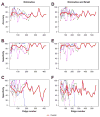Real-time optical biopsy of colon polyps with narrow band imaging in community practice does not yet meet key thresholds for clinical decisions
- PMID: 23041328
- PMCID: PMC5518757
- DOI: 10.1053/j.gastro.2012.09.054
Real-time optical biopsy of colon polyps with narrow band imaging in community practice does not yet meet key thresholds for clinical decisions
Abstract
Background & aims: Accurate optical analysis of colorectal polyps (optical biopsy) could prevent unnecessary polypectomies or allow a "resect and discard" strategy with surveillance intervals determined based on the results of the optical biopsy; this could be less expensive than histopathologic analysis of polyps. We prospectively evaluated real-time optical biopsy analysis of polyps with narrow band imaging (NBI) by community-based gastroenterologists.
Methods: We first analyzed a computerized module to train gastroenterologists (N = 13) in optical biopsy skills using photographs of polyps. Then we evaluated a practice-based learning program for these gastroenterologists (n = 12) that included real-time optical analysis of polyps in vivo, comparison of optical biopsy predictions to histopathologic analysis, and ongoing feedback on performance.
Results: Twelve of 13 subjects identified adenomas with >90% accuracy at the end of the computer study, and 3 of 12 subjects did so with accuracy ≥90% in the in vivo study. Learning curves showed considerable variation among batches of polyps. For diminutive rectosigmoid polyps assessed with high confidence at the end of the study, adenomas were identified with mean (95% confidence interval [CI]) accuracy, sensitivity, specificity, and negative predictive values of 81% (73%-89%), 85% (74%-96%), 78% (66%-92%), and 91% (86%-97%), respectively. The adjusted odds ratio for high confidence as a predictor of accuracy was 1.8 (95% CI, 1.3-2.5). The agreement between surveillance recommendations informed by high-confidence NBI analysis of diminutive polyps and results from histopathologic analysis of all polyps was 80% (95% CI, 77%-82%).
Conclusions: In an evaluation of real-time optical biopsy analysis of polyps with NBI, only 25% of gastroenterologists assessed polyps with ≥90% accuracy. The negative predictive value for identification of adenomas, but not the surveillance interval agreement, met the American Society for Gastrointestinal Endoscopy-recommended thresholds for optical biopsy. Better results in community practice must be achieved before NBI-based optical biopsy methods can be used routinely to evaluate polyps; ClinicalTrials.gov number, NCT01638091.
Copyright © 2013 AGA Institute. Published by Elsevier Inc. All rights reserved.
Conflict of interest statement
Conflicts of interest
The authors disclose the following: D. K. Rex has received research support and serves on the speaker’s bureau for Olympus Corp. The remaining authors disclose no conflicts.
Figures



References
-
- Rex DK, Kahi C, O’Brien M, et al. The American Society for Gastrointestinal Endoscopy PIVI (Preservation and Incorporation of Valuable Endoscopic Innovations) on real-time endoscopic assessment of the histology of diminutive colorectal polyps. Gastrointest Endosc. 2011;73:419–422. - PubMed
-
- Oba S, Tanaka S, Sano Y, et al. Current status of narrow-band imaging magnifying colonoscopy for colorectal neoplasia in Japan. Digestion. 2011;83:167–172. - PubMed
-
- Rastogi A, Keighley J, Singh V, et al. High accuracy of narrow band imaging without magnification for the real-time characterization of polyp histology and its comparison with high-definition white light colonoscopy: a prospective study. Am J Gastroenterol. 2009;104:2422–2430. - PubMed
-
- Rex DK. Narrow-band imaging without optical magnification for histologic analysis of colorectal polyps. Gastroenterology. 2009;136:1174–1181. - PubMed
-
- Sano Y, Ikematsu H, Fu KI, et al. Meshed capillary vessels by use of narrow-band imaging for differential diagnosis of small colorectal polyps. Gastrointest Endosc. 2009;69:278–283. - PubMed
Publication types
MeSH terms
Associated data
Grants and funding
LinkOut - more resources
Full Text Sources
Other Literature Sources
Medical
Miscellaneous

